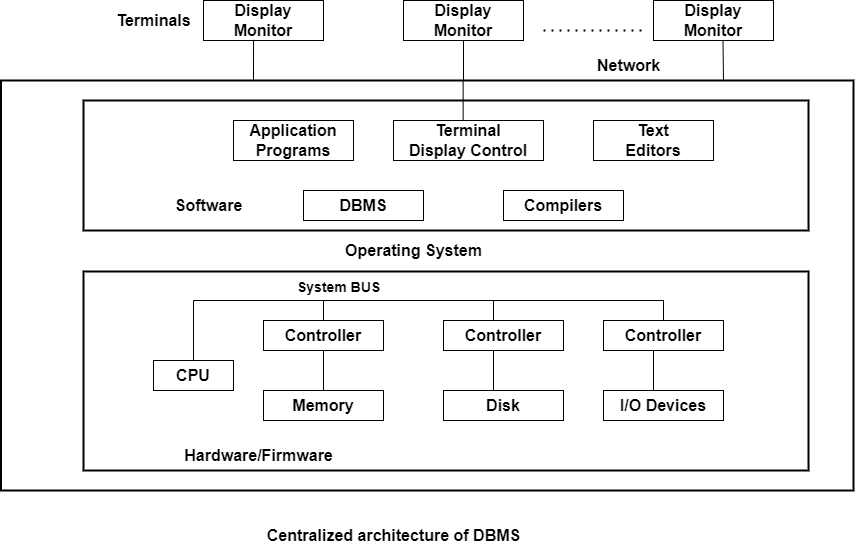Centralized and Client Server Architecture for DBMSCentralized Architecture of DBMS:Architectures for DBMSs have generally followed trends seen in architectures for larger computer systems. The primary processing for all system functions, including user application programs, user interface programs, and all DBMS capabilities, was handled by mainframe computers in earlier systems. The primary cause of this was that the majority of users accessed such systems using computer terminals with limited processing power and merely display capabilities. Only display data and controls were delivered from the computer system to the display terminals, which were connected to the central node by a variety of communications networks, while all processing was done remotely on the computer system. The majority of users switched from terminals to PCs and workstations as hardware prices decreased. Initially, Database Systems operated on these computers in a manner akin to how they had operated display terminals. As a result, the DBMS itself continued to operate as a centralized DBMS, where all DBMS functionality, application program execution, and UI processing were done on a single computer. The physical elements of a centralized architecture Client/server DBMS designs emerged as DBMS systems gradually began to take advantage of the user side's computing capability. 
Client-server Architecture of DBMS:We first talk about client/server architecture in general, and then we look at how DBMSs use it. In order to handle computing settings with a high number of PCs, workstations, file servers, printers, database servers, etc., the client/server architecture was designed. A network connects various pieces of software and hardware, including email and web server software. To define specialized servers with a particular functionality is the aim. For instance, it is feasible to link a number of PCs or compact workstations to a file server that manages the client machines' files as clients. By having connections to numerous printers, different devices can be designated as a printer server; all print requests from clients are then directed to this machine. The category of specialized servers also includes web servers and email servers. Many client machines can utilize the resources offered by specialized servers. The user is given the proper user interfaces for these servers as well as local processing power to run local applications on the client devices. This idea can be applied to various types of software, where specialist applications, like a CAD (computer-aided design) package, are kept on particular server computers and made available to a variety of clients. Some devices (such as workstations or PCs with discs that only have client software installed) would only be client sites. The idea of client/server architecture presupposes an underpinning structure made up of several PCs and workstations as well as fewer mainframe computers connected via LANs as well as other types of computer networks. In this system, a client is often a user machine that offers local processing and user interface capabilities. When a client needs access to extra features-like database access-that are not available on that system, it connects to a server that offers those features. A server is a computer system that includes both hardware and software that can offer client computer services like file access, printing, archiving, or database access. Generally speaking, some workstations install both client and server software, while others just install client software. Client and server software, however, typically run on separate workstations, which is more typical. On this underlying client/server framework, Two-tier and Three-tier fundamental DBMS architectures were developed. Two-Tier Client Server Architecture:Here, the term "two-tier" refers to our architecture's two layers-the Client layer and the Data layer. There are a number of client computers in the client layer that can contact the database server. The API on the client computer will use JDBC or some other method to link the computer to the database server. This is due to the possibility of various physical locations for clients and database servers. Three-Tier Client-Server Architecture:The Business Logic Layer is an additional layer that serves as a link between the Client layer and the Data layer in this instance. The layer where the application programs are processed is the business logic layer, unlike a Two-tier architecture, where queries are performed in the database server. Here, the application programs are processed in the application server itself.
Next TopicData Query Language
|
 For Videos Join Our Youtube Channel: Join Now
For Videos Join Our Youtube Channel: Join Now
Feedback
- Send your Feedback to [email protected]
Help Others, Please Share









